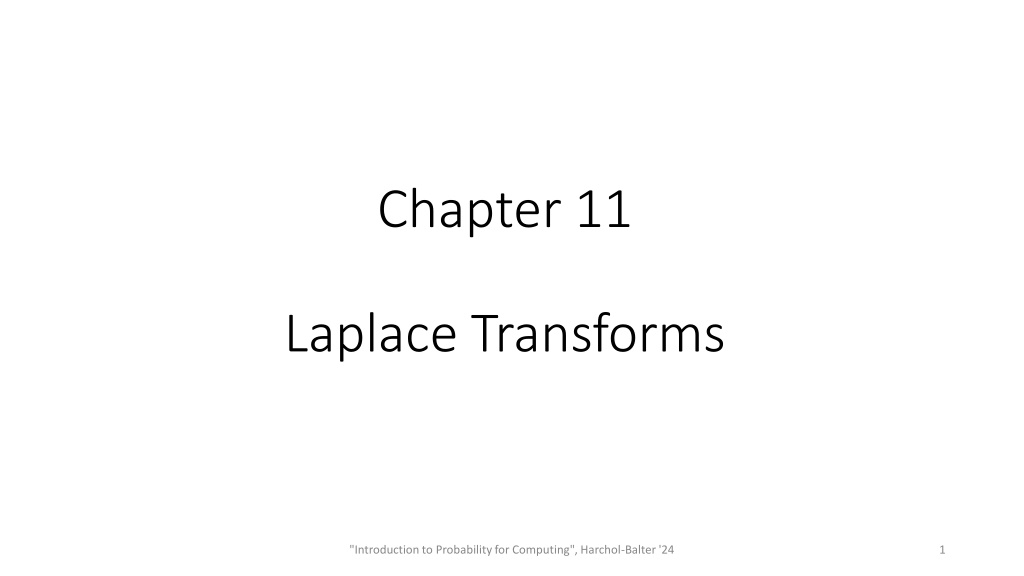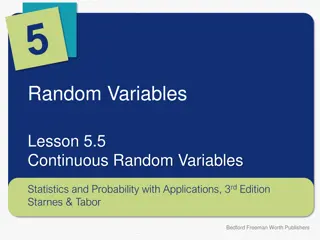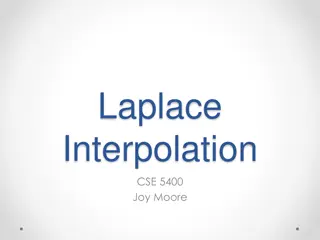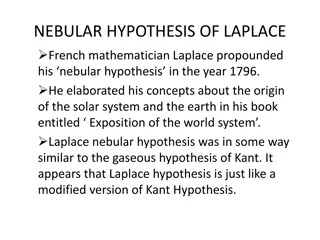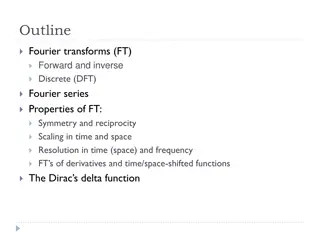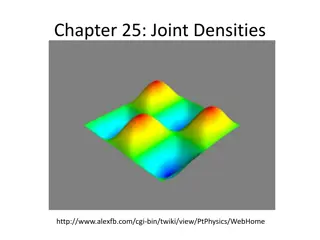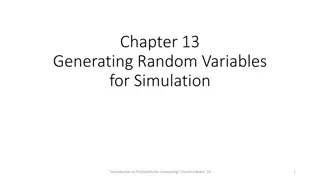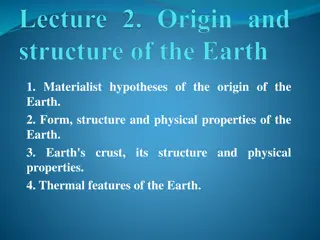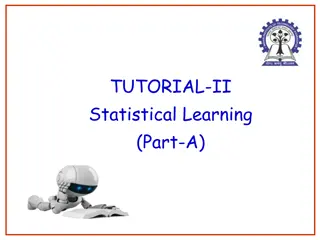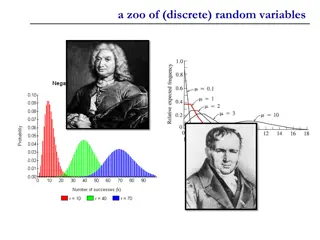Understanding Laplace Transforms for Continuous Random Variables
The Laplace transform is introduced as a generating function for common continuous random variables, complementing the z-transform for discrete ones. By using the Laplace transform, complex evaluations become simplified, making it easy to analyze different types of transforms. The transform of a continuous random variable with a non-negative continuous probability density function is explained, highlighting that convergence is guaranteed for non-negative random variables.
- Laplace Transforms
- Continuous Random Variables
- Generating Functions
- Probability Computing
- Transform Analysis
Download Presentation

Please find below an Image/Link to download the presentation.
The content on the website is provided AS IS for your information and personal use only. It may not be sold, licensed, or shared on other websites without obtaining consent from the author. Download presentation by click this link. If you encounter any issues during the download, it is possible that the publisher has removed the file from their server.
E N D
Presentation Transcript
Chapter 11 Laplace Transforms "Introduction to Probability for Computing", Harchol-Balter '24 1
There are different types of transforms Back in Chapter 6 we covered a type of generating function called the z-transform. The z-transform is particularly well suited to discrete, integer-valued random variables. In this chapter we introduce a new generating function called the Laplace transform, which is well suited to common continuous random variables. The structure of this chapter will closely mimic that of Chapter 6. 2 "Introduction to Probability for Computing", Harchol-Balter '24
Motivation Let ? ???(?) What is ? ?3? ? ?3= ?3 ?? ???? 0 Seems complicated to evaluate! The Laplace transform will make this very easy! 3 "Introduction to Probability for Computing", Harchol-Balter '24
The Laplace transform as an onion Onion represents Laplace transform of r.v. ? Lower moments are in the outer layers less effort/tears Higher moments are deeper inside more effort/tears 4 "Introduction to Probability for Computing", Harchol-Balter '24
Laplace transform of continuous r.v. Defn: Let ? be a non negative continuous r.v. with p.d.f. ??? . Then the Laplace transform of ? is ?(?) = ? ? ??= ? ????? ?? 0 Assume ? is a constant where ? 0. Note: The Laplace transform can be defined for any r.v., or even for just a function ? ? , where ? 0. However convergence is only guaranteed when ? is a non-negative r.v. and ? 0. 5 "Introduction to Probability for Computing", Harchol-Balter '24
Pop Quiz Defn: Let ? be a non negative continuous r.v. with p.d.f. ??? . Then the Laplace transform of ? is ?(?) = ? ? ??= ? ????? ?? 0 Assume ? is a constant where ? 0. Q: What is ? 0 ? A: ? 0 = ? ? 0 ?= 1 6 "Introduction to Probability for Computing", Harchol-Balter '24
Example of Onion Building ? ???(?) Create the onion! ? ? = ? ? ?? ?(?) = ? ? ??= ? ???? ???? 0 ? ????? ?? = 0 ? (?+?)??? = ? 0 ? = ? + ? 7 "Introduction to Probability for Computing", Harchol-Balter '24
Example of Onion Building ? = 3 Create the onion! ? ? = ? ? ?? ?(?) = ? ? ?? ? ????? ?? = = ?[? 3?] 0 = ? 3? 8 "Introduction to Probability for Computing", Harchol-Balter '24
Example of Onion Building ? ???????(?,?), where ?,? 0 Create the onion! ? ? = ? ? ?? ? 1 ?(?) = ? ? ??= ? ?? ? ??? ? ? ????? ?? = ? ? 1 1 0 ? ? ?? ? ?? = 9 "Introduction to Probability for Computing", Harchol-Balter '24
Convergence of Laplace transform Theorem 11.7: ? ? is bounded for any non negative continuous r.v. ?, assuming ? 0. ? ? 1, Proof: ? 0 ? ? ? 1, ? 0 ? ?? 1, ?,? 0 ? ? = ? ????? ?? 1 ??? ?? = 1 0 0 10 "Introduction to Probability for Computing", Harchol-Balter '24
Getting moments: Onion peeling Theorem 11.8: (Onion Peeling) Let ? be a non negative, continuous r.v. with p.d.f. ??? , ? 0. Then, ? ? s=0= ?[X] ? ? s=0= ?[X2] ? ? s=0= ?[X3] ? ? s=0= ?[X4] If can t evaluate at ? = 0, instead consider limit as ? 0 (use L Hospital s Rule). 11 "Introduction to Probability for Computing", Harchol-Balter '24
Proof of onion peeling theorem ??2 2! ??3 3! ??4 4! ? ??= 1 ?? + + (Taylor Series Expansion) ??2 2! ??3 3! ??4 4! ? ??? ? = ? ? ?? ? ? + ? ? ? ? + ? ? ??2 ??3 ? ??? ? ?? = ? ? ?? ?? ? ? ?? + ? ? ?? ? ? ?? + 2! 3! 0 0 0 0 0 ? ? = 1 ? ? ? +?2 2!? ?2 ?3 3!? ?3+?4 4!? ?4 ?5 5!? ?5+ 12 "Introduction to Probability for Computing", Harchol-Balter '24
Proof of onion peeling theorem ? ? = 1 ? ? ? +?2 2!? ?2 ?3 2!? ?3+?3 3!? ?3+?4 3!? ?4 ?4 4!? ?4 ?5 4!? ?5+?5 5!? ?5+?6 6!? ?6 ? ? = ? ? + ?? ?2 ?2 5!?[?6] ? 0 = ? ? ? ? = ? ?2 ?? ?3+?2 2!? ?4 ?3 3!? ?5+?4 4!? ?6 ? 0 = ?[?2] ? ? = ? ?3+ ?? ?4 ?2 2!? ?5+?3 3!? ?6 ? 0 = ?[?3] 13 "Introduction to Probability for Computing", Harchol-Balter '24
Example of onion peeling ? ? ? = ? + ?= ? ? + ? 1 ? ???(?) Q: Peel the onion to get ? ? , ?[?2],? ?3, ?[?4], ? ? =1 ? ? = ? ? + ? 2 ? ? ?2=2 ? ? = 2? ? + ? 3 ?2 ? ?3=3! ? ? = 3!? ? + ? 4 ?3 ? ??=?! ?? 14 "Introduction to Probability for Computing", Harchol-Balter '24
Linearity of Transforms Theorem 11.10: (Linearity) Let ? and ? be independent continuous r.v.s. Let ? = ? + ? Then the Laplace transform of ? is: ? ? = ? ? ? ? ? ? = ? ? ??= ?[? ? ?+?] Proof: = ?[? ?? ? ??] = ? ? ?? ? ? ?? = ? ? ? ? 15 "Introduction to Probability for Computing", Harchol-Balter '24
Conditioning with Transforms Theorem 11.11: Let ?, ?,and ? be continuous r.v.s. where ? = ? ? w.p. w.p. ? 1 ? Then, ?(?) = ? ?(?) + 1 ? ?(?) ?(?) = ? ? ?? Proof: = ? ? ??? = ?] ? + ? ? ??? = ?] (1 ?) = ?[? ??] ? + ?[? ??] (1 ?) = ? ?(?) + 1 ? ?(?) 16 "Introduction to Probability for Computing", Harchol-Balter '24
Conditioning Theorem 11.12: Let ? be a continuous r.v. and let ??be a continuous r.v. that dependes on ?. Let ??(?) denote the p.d.f. of ?. Then: ??? = ?=0 ??? ??? ?? ?= Proof: ??? = ? ? ??? = ? ? ???|? = ? ??? ?? ?=0 ?= ? ? ??? ??? ?? = ?=0 ??? ??? ?? = ?=0 17 "Introduction to Probability for Computing", Harchol-Balter '24
